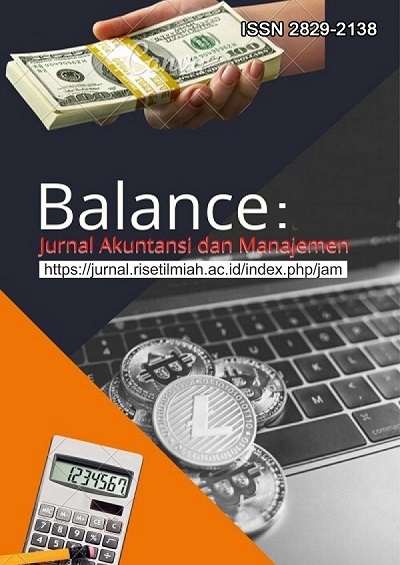Pengaruh Sensory Brand Experience Terhadap Brand Loyalty: Brand Self Connection Sebagai Mediator Studi Kasus Konsumen Hotel Ibis Samarinda
DOI:
https://doi.org/10.59086/jam.v4i2.863Keywords:
Sensory Brand Experience, Brand Self-ConnectionAbstract
This study aims to analyze the influence of Sensory Brand Experience on Brand Loyalty, with Brand Self-Connection as a mediating variable, using a case study of consumers at hotel Ibis Samarinda. A quantitative method was applied, utilizing surveys through structured questionnaires. Data were collected from 201 respondents and analyzed using Structural Equation Modeling–Partial Least Squares (PLS-SEM). The results show that Sensory Brand Experience has a positive and significant effect on both Brand Self-Connection and Brand Loyalty, directly and indirectly through the mediation of Brand Self-Connection. These findings contribute to the development of marketing strategies based on experiential and emotional brand connections in the hospitality sector.
Downloads
References
Alloza, A. (2008). Brand Engagement and Brand Experience at BBVA, the Transformation of a 150 Years Old Company. Corporate Reputation Review, 11(4), 371–379. https://doi.org/10.1057/crr.2008.31
Brakus, J. J., Schmitt, B. H., & Zarantonello, L. (2009). Brand Experience: What Is It? How Is It Measured? Does It Affect Loyalty? Journal of Marketing, 73(3), 52–68. https://doi.org/10.1509/jmkg.73.3.52
Cho, C.-H. (2004). Effects of Banner Clicking and Attitude toward the Linked Target Ads on Brand-Attitude and Purchase-Intention Changes. Journal of Global Academy of Marketing Science, 14(1), 1–16. https://doi.org/10.1080/12297119.2004.9707219
Escalas, J., & Bettman, J. (2003). You Are What They Eat: The Influence of Reference Groups on Consumers’ Connections to Brands. Journal of Consumer Psychology - J CONSUM PSYCHOL, 13. https://doi.org/10.1207/S15327663JCP1303_14
Husen, A. (2023). Strategi Pemasaran Melalui Digital Marketing Campaign Di Toko Mebel Sakinah Karawang. Jurnal Economina, 2(6), 1356–1362. https://doi.org/10.55681/economina.v2i6.608
Jasinskas, E., Streimikiene, D., Svagzdiene, B., & Simanavicius, A. (2016). Impact of hotel service quality on the loyalty of customers. Economic Research-Ekonomska Istrazivanja , 29(1), 559–572. https://doi.org/10.1080/1331677X.2016.1177465
Kruger, L.-M. (2018). Brand loyalty: Exploring self-brand connection and brand experience. Journal of Product & Brand Management, 27, 0. https://doi.org/10.1108/JPBM-07-2016-1281
Lin, J., Lobo, A., & Leckie, C. (2017). The role of benefits and transparency in shaping consumers’ green perceived value, self-brand connection and brand loyalty. Journal of Retailing and Consumer Services, 35, 133–141. https://doi.org/10.1016/j.jretconser.2016.12.011
Moreira, A. C., Da Silva, P. M. F., & Ferreira Moutinho, V. M. (2017). Les effets des expériences de marque sur la qualité, la satisfaction et la fidélité: Une étude empirique dans le domaine des services multiples de télécommunications. Innovar, 27(64), 23–38. https://doi.org/10.15446/innovar.v27n64.62366
Nasution, T. A. (2019). Faktor-faktor yang Mempengaruhi Strategic Business-IT Alignment: Studi Kasus pada Universitas Muhammadiyah Riau. 1–59.
Nursiti. (2018). JUMPA Vol. 5 No. 1 Februari 2018 Analisis Perbandingan Kesadaran Merek, Asosiasi Merek, Persepsi Kualitas, Dan Loyalitas Merek E-Commerce Lazada, Tokopedia, Dan Shopee (Studi Pada Pengguna E-Commerce). Jurnal Manajemen Dan Perbankan (JUMPA), 5(1), 1–20. https://doi.org/10.55963/jumpa.v5i1.241
Perkins, C. (2013). Aradhna Krishna (ed.), Sensory Marketing: Research on the Sensuality of Products . Journal of Consumer Culture, 13(1), 68–70. https://doi.org/10.1177/1469540512474532b
Rini, E. S., Rombe, E., & Tarigan, M. I. (2024). Brand destination loyalty: the antecedents of destination brand experience. Cogent Business and Management, 11(1). https://doi.org/10.1080/23311975.2024.2320992
Riza, A. F., & Wijayanti, D. M. (2018). The Triangle of Sensory Marketing Model: Does it Stimulate Brand Experience and Loyalty? Esensi: Jurnal Bisnis Dan Manajemen, 8(1). https://doi.org/10.15408/ess.v8i1.6058
Schmitt, B. (2009). The concept of brand experience. Journal of Brand Management, 16(7), 417–419. https://doi.org/10.1057/bm.2009.5
Tran, V. D., & Nguyen, N. T. T. (2022). Investigating the relationship between brand experience, brand authenticity, brand equity, and customer satisfaction: Evidence from Vietnam. Cogent Business and Management, 9(1). https://doi.org/10.1080/23311975.2022.2084968
Yanti, D. (2019). Pemanfaatan Digital Marketing dalam Industri Perhotelan di Kota Medan. Jurnal Ilmiah Akomodasi Agung, 6(2). https://doi.org/10.51827/jiaa.v6i2.37
Yusuf, M. (2022). Pengaruh Promosi, Gaya Hidup, dan Persepsi Risiko terhadap Niat Beli Motor Listrik menggunakan Metode SEM - PLS. G-Tech: Jurnal Teknologi Terapan, 6(2), 241–248. https://doi.org/10.33379/gtech.v6i2.1685
Zha, D., Foroudi, P., Melewar, T. C., & Jin, Z. (2024). Examining the Impact of Sensory Brand Experience on Brand Loyalty. Corporate Reputation Review, 2009. https://doi.org/10.1057/s41299-023-00175-x
Park, C. W., Macinnis, D. J., Priester, J., Eisingerich, A. B., & Iacobucci, D. (2010). Brand Attachment and Brand Attitude Strength: Conceptual and Empirical Differentiation of Two Critical Brand Equity Drivers. Journal of Marketing, 74(6), 1-17.
Ghozali, I., & Latan, H. (2015). Partial least squares konsep, teknik dan aplikasi menggunakan program smartpls 3.0 untuk penelitian empiris. Semarang: Badan Penerbit UNDIP, 4(1), 35–46.
Alloza, A. (2008). Brand Engagement and Brand Experience at BBVA, the Transformation of a 150 Years Old Company. Corporate Reputation Review, 11(4), 371–379. https://doi.org/10.1057/crr.2008.31
Brakus, J. J., Schmitt, B. H., & Zarantonello, L. (2009). Brand Experience: What Is It? How Is It Measured? Does It Affect Loyalty? Journal of Marketing, 73(3), 52–68. https://doi.org/10.1509/jmkg.73.3.52
Cho, C.-H. (2004). Effects of Banner Clicking and Attitude toward the Linked Target Ads on Brand-Attitude and Purchase-Intention Changes. Journal of Global Academy of Marketing Science, 14(1), 1–16. https://doi.org/10.1080/12297119.2004.9707219
Comission, E. (2016). 済無No Title No Title No Title (Vol. 4, Issue 1). https://books.google.co.id/books?id=Ko6bCgAAQBAJ&lpg=PA6&hl=id&pg=PA1#v=onepage&q&f=false
Escalas, J., & Bettman, J. (2003). You Are What They Eat: The Influence of Reference Groups on Consumers’ Connections to Brands. Journal of Consumer Psychology - J CONSUM PSYCHOL, 13. https://doi.org/10.1207/S15327663JCP1303_14
Husen, A. (2023). Strategi Pemasaran Melalui Digital Marketing Campaign Di Toko Mebel Sakinah Karawang. Jurnal Economina, 2(6), 1356–1362. https://doi.org/10.55681/economina.v2i6.608
Jasinskas, E., Streimikiene, D., Svagzdiene, B., & Simanavicius, A. (2016). Impact of hotel service quality on the loyalty of customers. Economic Research-Ekonomska Istrazivanja , 29(1), 559–572. https://doi.org/10.1080/1331677X.2016.1177465
Kruger, L.-M. (2018). Brand loyalty: Exploring self-brand connection and brand experience. Journal of Product & Brand Management, 27, 0. https://doi.org/10.1108/JPBM-07-2016-1281
Lin, J., Lobo, A., & Leckie, C. (2017). The role of benefits and transparency in shaping consumers’ green perceived value, self-brand connection and brand loyalty. Journal of Retailing and Consumer Services, 35, 133–141. https://doi.org/10.1016/j.jretconser.2016.12.011
Moreira, A. C., Da Silva, P. M. F., & Ferreira Moutinho, V. M. (2017). Les effets des expériences de marque sur la qualité, la satisfaction et la fidélité: Une étude empirique dans le domaine des services multiples de télécommunications. Innovar, 27(64), 23–38. https://doi.org/10.15446/innovar.v27n64.62366
Nasution, T. A. (2019). Faktor-faktor yang Mempengaruhi Strategic Business-IT Alignment: Studi Kasus pada Universitas Muhammadiyah Riau. 1–59.
Nursiti. (2018). JUMPA Vol. 5 No. 1 Februari 2018 Analisis Perbandingan Kesadaran Merek, Asosiasi Merek, Persepsi Kualitas, Dan Loyalitas Merek E-Commerce Lazada, Tokopedia, Dan Shopee (Studi Pada Pengguna E-Commerce). Jurnal Manajemen Dan Perbankan (JUMPA), 5(1), 1–20. https://doi.org/10.55963/jumpa.v5i1.241
Perkins, C. (2013). Aradhna Krishna (ed.), Sensory Marketing: Research on the Sensuality of Products . Journal of Consumer Culture, 13(1), 68–70. https://doi.org/10.1177/1469540512474532b
Rini, E. S., Rombe, E., & Tarigan, M. I. (2024). Brand destination loyalty: the antecedents of destination brand experience. Cogent Business and Management, 11(1). https://doi.org/10.1080/23311975.2024.2320992
Riza, A. F., & Wijayanti, D. M. (2018). The Triangle of Sensory Marketing Model: Does it Stimulate Brand Experience and Loyalty? Esensi: Jurnal Bisnis Dan Manajemen, 8(1). https://doi.org/10.15408/ess.v8i1.6058
Schmitt, B. (2009). The concept of brand experience. Journal of Brand Management, 16(7), 417–419. https://doi.org/10.1057/bm.2009.5
Tran, V. D., & Nguyen, N. T. T. (2022). Investigating the relationship between brand experience, brand authenticity, brand equity, and customer satisfaction: Evidence from Vietnam. Cogent Business and Management, 9(1). https://doi.org/10.1080/23311975.2022.2084968
Yanti, D. (2019). Pemanfaatan Digital Marketing dalam Industri Perhotelan di Kota Medan. Jurnal Ilmiah Akomodasi Agung, 6(2). https://doi.org/10.51827/jiaa.v6i2.37
Yusuf, M. (2022). Pengaruh Promosi, Gaya Hidup, dan Persepsi Risiko terhadap Niat Beli Motor Listrik menggunakan Metode SEM - PLS. G-Tech: Jurnal Teknologi Terapan, 6(2), 241–248. https://doi.org/10.33379/gtech.v6i2.1685
Zha, D., Foroudi, P., Melewar, T. C., & Jin, Z. (2024). Examining the Impact of Sensory Brand Experience on Brand Loyalty. Corporate Reputation Review, 2009. https://doi.org/10.1057/s41299-023-00175-x
Downloads
Published
How to Cite
Issue
Section
License
Copyright (c) 2025 Dewi Sinta Fitriah, Marsha Anindita, Istimaroh Istimaroh

This work is licensed under a Creative Commons Attribution 4.0 International License.
This is an open-access journal. All works are published under the Creative Commons license CC-BY which means that all content is freely available at no charge to the user or his/her Institution. Users are allowed to read, download, copy, write, improve, and create derivative creation even for other lawful purposes, this license permits anyone to, as long as they cite and license the derivative creation under similar terms

This work is licensed under a Creative Commons Attribution 4.0 International License.
Most read articles by the same author(s)
- Nurasyikin, Asmadhini Handayani Rahmah, Marsha Anindita , Pengaruh Stres Kerja, Job Burnout, Dan Work- Life Balance Terhadap Turnover Intention Pada Part-Time Working Student di Kota Samarinda , Balance : Jurnal Akuntansi dan Manajemen: Vol. 4 No. 2 (2025): Agustus 2025
- Nur Anuwar, Marsha Anindita , Asmadhini Handayani Rahmah, Pengaruh Human Resource Development Dan Follower-Leader Goal Congruence Terhadap Organizational Commitment Pada Pekerja Generasi Z , Balance : Jurnal Akuntansi dan Manajemen: Vol. 4 No. 2 (2025): Agustus 2025


















